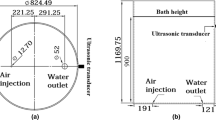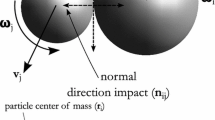Abstract
In top-blowing operations, the gas jet is a major source of momentum, so to model the momentum exchange properly with the liquid, the full-stress boundary conditions must be applied. A new mathematical method for better representation of the surface boundary condition was developed by combining the Cartesian cut cell method and volume of fluid method. The computational code was validated with the broken dam problem and reported critical phenomena in wave generation. The model was applied to impinging jets on liquid surfaces in two dimensions. The cavity depth was in good agreement with experimental measurements. The process of ligament and droplet formation was reproduced. The extent of momentum transfer to the liquid was investigated, and the trends with lance height and gas flow rate were similar to experimental evidence. The following important aspects of momentum transfer were identified: surface roughness as well as the development of local pressure gradients around wave crests. Kelvin–Helmholtz instability theory was used to interpret the results with respect to critical velocity for the onset of droplet formation. These principles were extended to conditions relevant to basic oxygen furnace (BOF) steelmaking. The critical velocities for droplets were calculated as functions of the physical properties for the gas–steel, gas–slag, slag–steel interfaces. The implications for BOF steelmaking were discussed. The mathematical model was applied to a simplified configuration of full-scale BOF steelmaking, and the local force balance was well described.




























Similar content being viewed by others
References
W.E. Olmstead and S. Raynor: J. Fluid Mech., 1964, vol. 19, pp. 561-76.
R.S. Rosler and G.H Stewart: J. Fluid Mech., 1968, vol. 31, pp. 163-74.
M. Evestedt and A. Medvedev: AISTech 2004 Proc., vol. 1, pp. 763–71.
J.-M. Vanden-Broeck: J. Fluid Mech., 2002, vol. 451, pp. 193-201.
B. Spivak, J.-M. Vanden-Broeck, and T. Miloh: Eur. J. Mech. B Fluids, 2002, vol. 21, pp. 207-24.
M. Mallewong, J. Asavanant, and R. Grimshaw: Adv. Fluid Mech., 2004, vol. 40, pp. 219–66.
F. Qian, B. Farouk, and R. Mutharasan: EPD Congress, 1995, pp. 127–41.
F. Qian, B. Farouk, R. Mutharasan, and N. Macken: J. Heat Transfer, 1999, vol. 121, pp. 333-40.
O. Olivares, A. Elias, R. Sánchez, M. Diáz-Cruz, and R.D. Morales: Steel Res., 2002, vol. 73 (2), pp. 44–51.
S.E. Forrester and G.M Evans: 3 rd CFX Int. Users Conf., 1996, pp. 559–63.
A. Nguyen and E.G. Evans: 3 rd Int. Conf. on CFD in the Mineral and Process Industries, 2003, pp. 71–76.
H.-J. Odenthal, W.H. Emling, J. Kempken, and J. Schlüter: AISTech, 2007, p. 18.
H.Y. Hwang and G.A. Irons: Applied Math. Modeling, 2009, in press.
S. Muzaferija and M Perić: Numer. Heat Transfer B, 1997, vol. 32, pp. 369-84.
J.L. Thé, G.D. Raithby, and G.D. Stubley: Numer. Heat Transfer B, 1994, vol. 26, pp. 367–80.
A. Egelja, M. Schafer, and F. Durst: IJCFD, 1998, vol. 10, pp. 213-34.
C.W. Hirt and B.D. Nichols: J. Comput. Phys., 1981, vol. 39, pp. 201-25.
D.L. Young: Numerical Method for Fluid Dynamics, Acadamic Press, New York, NY, 1981, pp. 273-85.
W. Shyy, S. Udaykumar, M.M. Rao, and R.W. Smith: Computational Fluid Dynamics with Moving Boundaries, Washington, DC: Hemisphere, 1996, pp. 195-248.
H.S. Udaykumar, W. Shyy, and M.M. Rao: Int. J. Numer. Methods Fluids, 1996, vol. 22, pp. 691-712.
H.S. Udaykumar, R. Mittal, P. Rampnggoon, and A. Khanna: J. Comput. Phys., 2001, vol. 174, pp. 345-80.
W.J. Coirier and K.G. Powell: J. Comput. Phys., 1995, vol. 117, pp. 121-31.
M. Rudman: Int. J. Numer. Methods Fluids, 1997, vol. 24, pp. 671-91.
D.J. Benson: Appl. Mech. Rev., 2002, vol. 55, pp. 151-65.
E.G. Puckett, A.S. Almgren, J.B. Bell, D.L. Marcus, and W.J. Rider: J. Comput. Phys., 1997, vol. 130, pp. 269-82.
M.A. Martorano, M.A. Fortes, and A. F. Padilha: Model. Simul. Mater. Sci. Eng., 2006, vol. 14, pp. 83-98.
C. A. J. Fletcher: Computational Techniques for Fluid Dynamics, vol. 1, 2nd ed., Springer, Berlin, Germany, 1991.
D.K. Clarke, M.D. Salas, and H.A. Hassan: AIAA J., 1986, vol. 24, pp. 353-58.
G. Yang, D.M. Causon, D.M. Ingram, R. Saunders, and P. Battern: Aeronaut. J., 1997, pp. 47–56.
J. H. Ferziger and M. Perić: Computational Methods for Fluid Dynamics, 3rd ed., Springer, Berlin, Germany, 2002.
I. Demirdžić and M. Perić: Int. J. Numer. Methods Fluids, 1988, vol. 8, pp. 1037-50.
R.J. Renka: ACM Trans. Math. Soft., 1999, vol. 25, pp. 78-94.
R. J. Renka: ACM Trans. Math. Soft., 1988, vol. 14, pp. 138-48.
R. J. Renka: ACM Trans. Math. Soft., 1988, vol. 14, pp. 149-50.
G. Son and N. Hur: Numer. Heat Transfer B, 2002, vol. 42, pp. 523-42.
D. Gueyffier, J. Li, A. Nadim, R. Scadovelli and S. Zaleski: J. Comput. Phys., 1999, vol. 152, pp. 423-56.
J. Martin and W.J. Moyce: Philos. Trans. R. Soc. London, Ser. A, 1952, vol. 244 (882), pp. 312–24.
L. Qian, D.M. Causon, D.M. Ingram, and C.G. Mingham: J. Hydraul. Eng., 2003, vol. 129, pp. 688-96.
D. Guo and G.A. Irons: Metall. Mater. Trans. B, 2002, vol. 33B, pp. 377–83.
D. Greaves: Int. J. Numer. Methods Fluids, 2004, vol. 44, pp. 1093-1117.
J.H. Jeong and D.Y. Yang: Int. J. Numer. Methods Fluids, 1998, vol. 26, pp. 1127-54.
W.H. Munk: J. Mar. Res., 1947, vol. 6, pp. 203-18.
O.M. Phillips: J. Fluid Mech., 1957, vol. 2, pp. 417-45.
M.A.C. Teixeira and S.E. Belcher: Dynam. Atmos. Oceans, 2006, vol. 41, pp. 1–27.
H. Mitsuyasu and T. Honda: J. Fluid Mech., 1982, vol. 123, pp. 425–42.
H.Y. Hwang and G.A. Irons: AISTech, 2009, vol. 1, pp. 769-80.
H. Schlichting: Boundary Layer Theory, McGraw-Hill, New York, NY, 1979.
N. Rajaratnam: Turbulent Jets, Elsevier, Amsterdam, The Netherlands, 1976.
P. Lombardi, V. De Angelis, and S. Banerjee: Phys. Fluids, 1996, vol. 8, pp. 1643–65
J. Szekely: Fluid Flow Phenomena in Metals Processing, Acadamic Press, New York, NY, 1979.
R.B. Banks and D.V. Chandrasekhara: J. Fluid Mech., 1963, vol. 15, pp. 13-34.
S. Chandrasekhar: Hydrodynamic and Hydromagnetic Stability, Dover Publications, New York, NY, 1961.
T. Funda and D.D. Joseph: J. Fluid Mech., 2001, vol. 445, pp. 263–83.
H.D. Ceniceros: Phys. Fluid, 2003, vol. 15, pp. 245-56.
X. Liu and J.H. Duncan: Nature, 2003, vol. 421, pp. 520-23.
G.C. Smith: J. Metals, 1966, pp. 846–51.
J. Perez: private communication, December 11, 2007.
B. Deo and R. Boom: Fundamentals of Steelmaking Metallurgy, Prentice Hall International, New York, NY, 1993.
F.P. Ricou and D.B. Spalding: J. Fluid Mech., 1961, vol. 11, pp. 21-32.
Y. Kawai and Y. Shiraishi: Handbook of Physico-Chemical Properties at High Temperature, ISIJ, Tokyo, Japan, 1988.
K.C. Mills, Y. Su, A.B. Fox, Z. Li, R.P. Thackray, and H.T. Tsai: ISIJ Int., 2005, vol. 45, pp. 619-33.
VDEh: Slag Atlas, 2nd ed., Verlag Sthleisen GmbH, Dűseldorf, Germany, 1995.
Q. Shu and J. Zhang: ISIJ Int., 2006, vol. 46, pp. 1548-53.
P. Vadász, M. Havlík, and V. Danĕk: Can. Metall. Q., 2000, vol. 39, pp. 143-52.
K. Krishnapisharody and G. Irons: AISTech 2008, May 5–8, 2008, David L. Lawrence Convention Center, Pittsburgh, PA, vol. 1, p. 10, Association for Iron & Steel Technology (AIST), Warrendale, PA, 2008
Author information
Authors and Affiliations
Corresponding author
Additional information
Manuscript submitted January 8, 2011.
Rights and permissions
About this article
Cite this article
Hwang, H.Y., Irons, G.A. Mathematical Modeling of Impinging Gas Jets on Liquid Surfaces. Metall Mater Trans B 42, 575–591 (2011). https://doi.org/10.1007/s11663-011-9493-6
Published:
Issue Date:
DOI: https://doi.org/10.1007/s11663-011-9493-6




